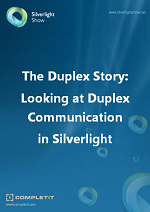

The Duplex Story: Looking at Duplex Communication in Silverlight
Author: Gill Cleeren
Price: $0.99 
Formats: PDF, Word, EPUB, MOBI. All source code added to the downloadable package.
Number of pages: 20
Release date: July 2011
This e-book collects all 3 parts of the series 'The Duplex Story: Looking at Duplex Communication in Silverlight', together with source code.
Silverlight offers us many choices to work with services to get data into our applications. Supported technologies include WCF, ASMX, REST, WCF RIA Services etc. Through the use of any of these, it’s quite easy to get data from the server to the client application and vice versa. They all have one thing in common: before the data is sent, the client has to perform a request to the server to do so. The communication is known to be client-initiated.
But what if the server wants to initiate communication by sending some data to the client, without there being a request first? In this case, we need to use duplex communication, so that both sides of the communication channel can start sending data.
In this 3 chapter e-book, we’ll look at the options that Silverlight has on board to perform duplex communication. Inside each chapter you may find a link to the source code used throughout the chapter examples. All source codes are available with this e-book package.
Contents:
Chapter 1: Introduction
The need for duplex communication
Advantages of duplex communication
Types of duplex communication in Silverlight
The HTTP Polling Duplex Binding in Silverlight
Internals of the HTTP Polling Duplex
The binding
The service
Clients
Conclusion
Chapter 2: Using Sockets
Duplex with sockets
Advantages and disadvantages of sockets
The road to duplex sockets
Policy Server
The socket server
The client
Conclusion
Chapter 3: Using Net.Tcp
Advantages of using net.tcp
Server-side code
Client-side code
Summary 23
About the author:
 Gill Cleeren is Microsoft Regional Director (www.theregion.com), Silverlight MVP (former ASP.NET MVP), INETA speaker bureau member and Silverlight Insider. He lives in Belgium where he works as .NET architect at Ordina. Passionate about .NET, he’s always playing with the newest bits. In his role as Regional Director, Gill has given many sessions, webcasts and trainings on new as well as existing technologies, such as Silverlight, ASP.NET and WPF at conferences including TechEd Berlin 2010, TechDays Belgium, DevDays NL, NDC Oslo Norway, SQL Server Saturday Switserland, Spring Conference UK, Silverlight Roadshow in Sweden and others. He’s also the author of many articles in various developer magazines and for SilverlightShow.net (check Gill's articles for SilverlightShow). He organizes the yearly Community Day event in Belgium.
Gill Cleeren is Microsoft Regional Director (www.theregion.com), Silverlight MVP (former ASP.NET MVP), INETA speaker bureau member and Silverlight Insider. He lives in Belgium where he works as .NET architect at Ordina. Passionate about .NET, he’s always playing with the newest bits. In his role as Regional Director, Gill has given many sessions, webcasts and trainings on new as well as existing technologies, such as Silverlight, ASP.NET and WPF at conferences including TechEd Berlin 2010, TechDays Belgium, DevDays NL, NDC Oslo Norway, SQL Server Saturday Switserland, Spring Conference UK, Silverlight Roadshow in Sweden and others. He’s also the author of many articles in various developer magazines and for SilverlightShow.net (check Gill's articles for SilverlightShow). He organizes the yearly Community Day event in Belgium.
He also leads Visug (www.visug.be), the largest .NET user group in Belgium. Gill recently published his first book: “Silverlight 4 Data and Services Cookbook” (Packt Publishing). You can find his blog at www.snowball.be. Gill tweets from @gillcleeren.
Gill has delivered the following webinars for SilverlightShow (links to recordings):
Blend for Silverlight Developers
Switch or no Switch: Can I Build My Business Apps in LightSwitch?
Switching on the Cloud for Silverlight
Building a Silverlight 4 Application End-to-end
10 things I'm sure you didn't know about Silverlight 4
Let's MEF: overview of the Managed Extensibility Framework in Silverlight 4
Silverlight's Power Features: Data Binding in Action